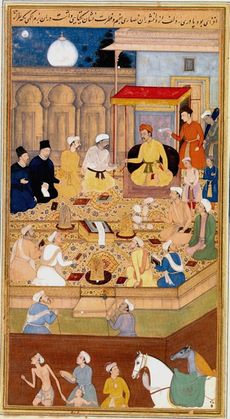Akbar the Great: Difference between revisions
(Added image) |
mNo edit summary |
||
| Line 1: | Line 1: | ||
[[File:Portrait of Akbar by Manohar.jpg|thumb|upright=0.6|alt=caption|Portrait of Akbar (late 16th century)]] | [[File:Portrait of Akbar by Manohar.jpg|thumb|upright=0.6|alt=caption|Portrait of Akbar (late 16th century)]] | ||
Abu | Abu'l-Fath Jalal ud-din Muhammad Akbar (1542–1605), greatest of Mogul emperors, an embodiment of the Ascended Master [[El Morya]]. | ||
== Early life == | == Early life == | ||
Akbar was born in 1542 at Umarkot. The sixteenth century Mogul Empire of India had been effectively reduced by fierce alien conquest until, in 1556, only the capital city, Delhi, remained when Akbar Jalal | Akbar was born in 1542 at Umarkot. The sixteenth century Mogul Empire of India had been effectively reduced by fierce alien conquest until, in 1556, only the capital city, Delhi, remained when Akbar Jalal ud-din Mohammed inherited the throne. | ||
[[File:Kaiser Akbar bändigt einen Elefanten.jpg|thumb|upright|left|alt=caption|Akbar training an elephant]] | [[File:Kaiser Akbar bändigt einen Elefanten.jpg|thumb|upright|left|alt=caption|Akbar training an elephant]] | ||
| Line 39: | Line 39: | ||
== Sources == | == Sources == | ||
{{ | {{POWref|28|51}} | ||
[[Category:Embodiments of El Morya]] | [[Category:Embodiments of El Morya]] | ||
Revision as of 19:36, 16 June 2016

Abu'l-Fath Jalal ud-din Muhammad Akbar (1542–1605), greatest of Mogul emperors, an embodiment of the Ascended Master El Morya.
Early life
Akbar was born in 1542 at Umarkot. The sixteenth century Mogul Empire of India had been effectively reduced by fierce alien conquest until, in 1556, only the capital city, Delhi, remained when Akbar Jalal ud-din Mohammed inherited the throne.
Not yet fourteen at his accession, the brilliant young Emperor Akbar set out to reconquer his realm. He became known throughout the world as Akbar the Great—the most powerful of the Mogul emperors. Tremendous physical stamina characterized Emperor Akbar and contributed to his extraordinary military success—he could ride 240 miles in twenty-four hours to surprise and defeat the enemy. Nevertheless, it took the major part of his long reign (1556–1605) to subject the rebellious princes of northern India and to secure peace by establishing sound provincial governments.
Akbar was endowed with a genius for administration. He increased trade efficiency by constructing roads, by developing advanced marketing systems, and by instituting postal services. In wise concern for all peoples under his jurisdiction, Akbar abolished the hated jizya, the poll-tax levied on non-Muslims, and gave Hindus prominent positions in government. The new capital city, Fatehpur Sikri, soon became a flourishing cultural center larger than the city of London at that time.
Akbar strongly supported Indian art, and under his direction more than one hundred workshops were established for the crafts. The emperor himself was very fond of music and encouraged it as a means of communication between Hindus and Muslims. Although illiterate, Akbar’s library of illustrated manuscripts was as celebrated as the finest collections in Europe.
By the end of his fifty-year rule in 1605, the small territory he had inherited was an empire that extended from the Hindu Kush to the Godavari River and from Bengal to Gujarat (present-day Bangladesh and most of Nepal, India, Pakistan and Afghanistan). Through Akbar’s military genius and vigorous leadership, the Mogul empire became one of the most powerful in the world. He implemented numerous administrative reforms that strengthened the governmental structure, abolished extortion, and centralized the financial system. Although he could neither read nor write, Akbar ably conversed with scholars and religious men and sponsored a renaissance in art and literature.

Religious tolerance
The emperor was born a Muslim but respected Hindu religion and culture and offered Hindus and Muslims alike the highest posts in his government. He assembled scholars of the Muslim and Hindu sects, Jains, Zoroastrians, and Jesuits in his capital, where in 1575 he built an ibadat khana, a “house of worship,” where learned men of all religions could meet to discuss both theology and philosophy. In 1582 Akbar founded a monotheistic, unitarian religion called Din-i-Ilahi (“Divine Faith”) with himself as its spiritual leader.
In an attempt to resolve the discord among the many religious factions in his empire, and recognizing the limitations of each, he proposed that “we ought, therefore, to bring them all into one, but in such fashion that they should be both ‘one’ and ‘all’, with the great advantage of not losing what is good in any one religion, while gaining whatever is better in another.” He did not, however, demand that his countrymen espouse his beliefs, and Akbar’s new religion had few adherents outside his court.
Final years
At the end of his reign, the peace and prosperity which Akbar had brought to India was disturbed by the court intrigues and subversive activities of his son, Jahangir. When he inherited the throne, Jahangir rejected his father’s reforms, especially those of religious tolerance, and the empire rapidly crumbled. Jahangir’s son and heir, Shah Jahan, inherited only a small and unruly kingdom but retained a great love for the cultural heritage of his grandfather. As the greatest of the Mogul builders, Shah Jahan gave to India its most cherished romance: the Taj Mahal.
See also
For more information
Mark L. Prophet and Elizabeth Clare Prophet, Lords of the Seven Rays.
Sources
Pearls of Wisdom, vol. 28, no. 51.
